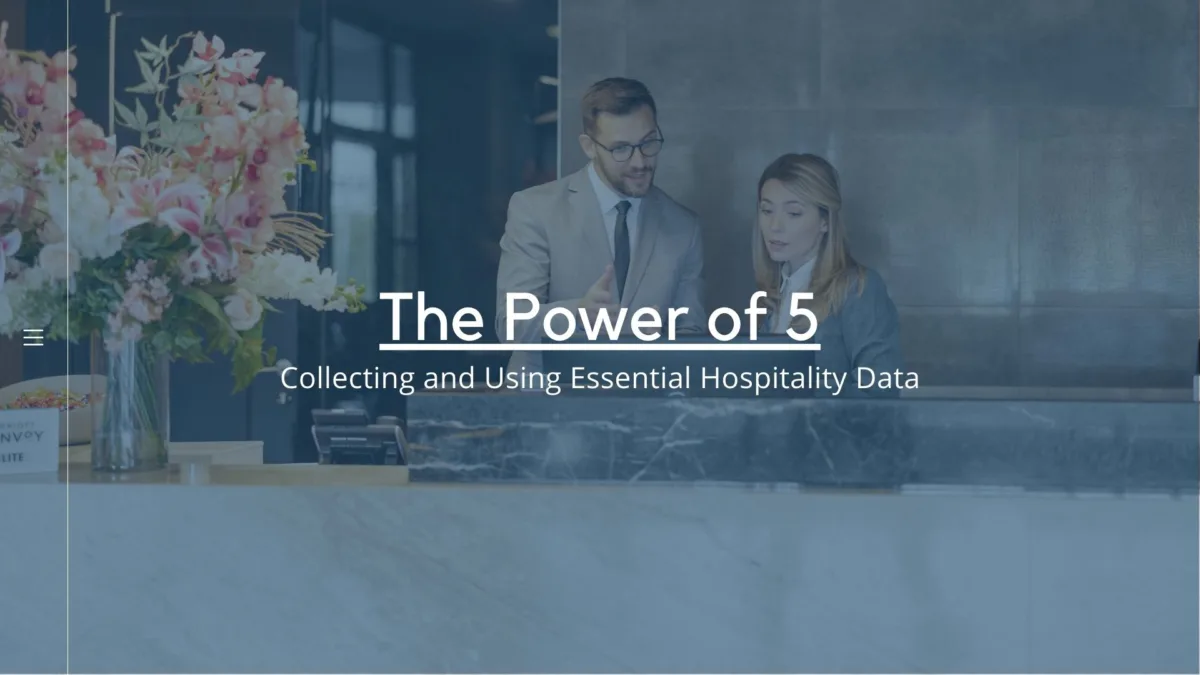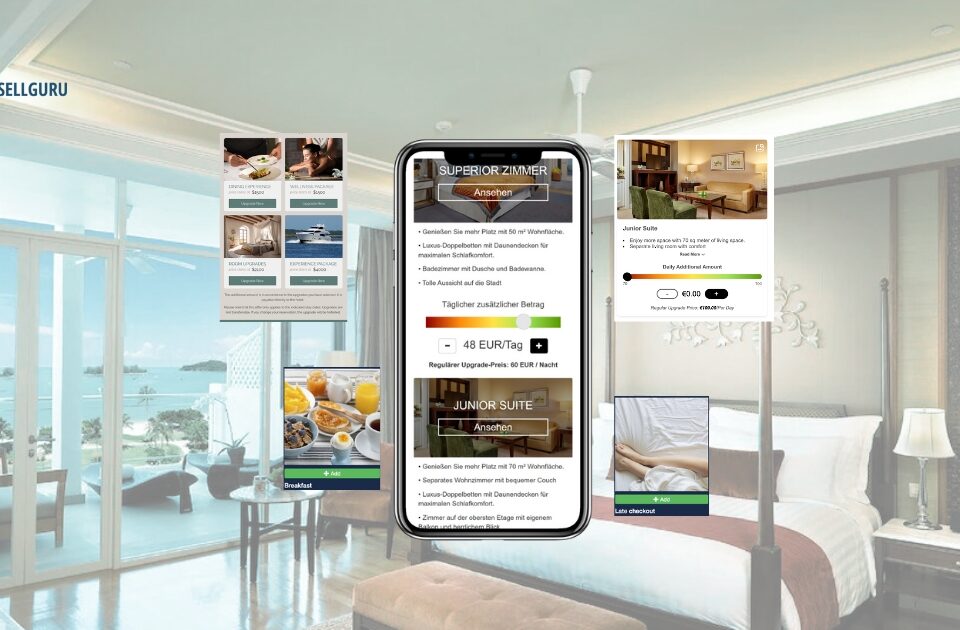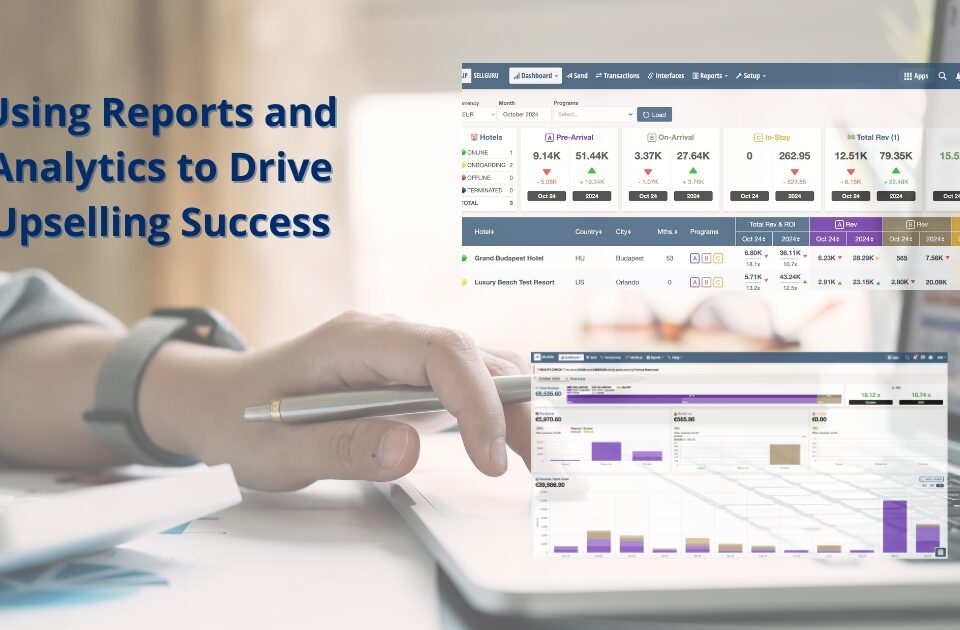The Power of 5: Leveraging Your Hotel Data

Hotel Upselling Ideas: St Patrick’s Day
March 16, 2023
Gamifying Upselling Boosts Revenue and Transforms Front Desk Agents into Superstars
March 30, 2023In the hospitality industry, data is everything. From customer preferences to revenue management, having access to the right information can help hotels make informed decisions that lead to increased revenue and guest satisfaction. However, with so many types of data available, it can be overwhelming to know what to collect and how to use it effectively. In this article, we'll explore five types of hospitality data, how to collect them, and how to use them to your advantage.

Booking Information
Tracking booking data is a critical part of a hotel's revenue management strategy. By collecting and analyzing data on lead time, booking channel, and room type, hotels can optimize their pricing and inventory strategies to maximize revenue and improve the overall guest experience.
Lead time refers to the amount of time between when a guest makes a reservation and the date of their arrival. By tracking lead time, hotels can adjust their pricing and inventory strategies to optimize revenue. For example, if a hotel has a high number of last-minute bookings, it may offer discounted rates to fill vacant rooms. Conversely, if a hotel has a high number of bookings made far in advance, it may increase rates to take advantage of demand.
Booking channel refers to the method guests use to make a reservation, such as through a hotel's website, a third-party booking site, or a travel agent. By tracking booking channel data, hotels can adjust their pricing and inventory strategies to optimize revenue and reduce distribution costs. For example, if a hotel has a high number of bookings made through a third-party booking site, it may adjust its pricing and inventory strategies to encourage more direct bookings through its website.
Room type refers to the type of room booked by a guest, such as a standard room, suite, or deluxe room. By tracking room type data, hotels can optimize their inventory strategies to ensure they have the right mix of room types available to meet guest demand. For example, if a hotel has a high number of bookings for suites, it may increase the number of suites available or adjust pricing to maximize revenue.
Tracking booking data can also inform revenue management decisions, such as forecasting demand, setting pricing strategies, and managing inventory. By analyzing trends in booking patterns, hotels can identify opportunities to increase revenue and improve the guest experience.
Lets not forget about the basics...
Obtaining basic information, such as a guest’s name, physical address, phone number, and email address is a crucial first step in guest data collection. This information makes it possible to reach out with direct mail and email marketing campaigns.

Guest Demographics
Collecting guest demographics such as age, gender, and location is an important part of understanding a hotel's target market and tailoring its marketing efforts to specific guest segments. By understanding guest demographics, hotels can create more personalized and effective marketing campaigns, improve guest satisfaction, and drive revenue growth.
Age is an essential demographic to consider because different age groups have different preferences and needs. For example, younger guests may be more interested in technology and social media, while older guests may prefer more traditional amenities and services. By understanding the age demographics of their guests, hotels can tailor their amenities and services to better meet the needs and preferences of their target market.
Gender is another demographic that can inform marketing and service offerings. For example, if a hotel has a high percentage of female guests, it may consider offering spa services or women-only floors. Similarly, if a hotel has a high percentage of male guests, it may offer more sports-related amenities or activities.
Location is also an essential demographic to consider because it can inform marketing efforts and service offerings. For example, if a hotel is located near a popular tourist attraction, it may offer packages or promotions tailored to that attraction. If a hotel is located in a business district, it may offer amenities and services targeted towards business travelers, such as conference rooms or business centers.
Collecting guest demographics can also inform decisions about room amenities, restaurant offerings, and other hotel services. For example, if a hotel has a high percentage of families with children, it may offer amenities such as cribs or family-friendly activities. If a hotel has a high percentage of international guests, it may offer multilingual staff or international cuisine in its restaurants.

Revenue Data
Tracking revenue data such as RevPAR, ADR, and occupancy rate is a crucial part of revenue management in the hospitality industry. These metrics provide valuable insights into a hotel's financial performance, which can inform pricing and inventory strategies and drive revenue growth.
RevPAR, which stands for Revenue Per Available Room, is a metric used to measure a hotel's revenue generation. It is calculated by dividing total room revenue by the number of available rooms. RevPAR is an essential metric because it takes into account both occupancy rate and ADR, providing a more comprehensive picture of a hotel's revenue performance.
ADR, or Average Daily Rate, is the average price paid for a room per day. It is calculated by dividing total room revenue by the number of rooms sold. ADR is a useful metric because it helps hotels understand how pricing affects their revenue performance. By tracking ADR, hotels can adjust their pricing strategies to optimize revenue.
Occupancy rate measures the percentage of available rooms that are occupied during a specified period. It is calculated by dividing the number of rooms sold by the number of available rooms. Occupancy rate is a key metric because it reflects how well a hotel is utilizing its inventory. A high occupancy rate may indicate that a hotel is underpricing its rooms, while a low occupancy rate may suggest that a hotel is overpricing its rooms.
By tracking RevPAR, ADR, and occupancy rate, hotels can optimize their pricing and inventory strategies to maximize revenue. For example, if a hotel's occupancy rate is high, but its ADR is low, the hotel may consider raising prices to increase revenue. Similarly, if a hotel's RevPAR is declining, it may need to adjust its pricing and inventory strategies to improve revenue performance.
Additionally, tracking revenue data can help hotels identify trends in revenue performance and make data-driven decisions about revenue management. For example, if a hotel sees a trend of declining RevPAR during a particular season, it may need to adjust pricing and inventory strategies to better align with demand.

Staff Performance
Tracking staff performance data is an essential part of improving the overall guest experience at a hotel. Two key metrics that hotels can use to track staff performance are upsell conversion rate and guest satisfaction scores.
Upsell conversion rate is the percentage of guests who accept an upgrade or additional service offered by a staff member. By tracking upsell conversion rate, hotels can identify which staff members are successful at upselling and which may need additional training. Additionally, tracking upsell conversion rate can inform decisions about staffing levels, as hotels can determine how many staff members are needed to achieve their upselling goals.
Guest satisfaction scores measure how satisfied guests are with their overall experience at a hotel. By tracking guest satisfaction scores, hotels can identify areas for improvement in their staff training programs. For example, if guests consistently rate the friendliness of staff members low, hotels can provide additional training to improve staff's interpersonal skills. Additionally, tracking guest satisfaction scores can inform decisions about performance incentives, as hotels can reward staff members who consistently receive high satisfaction scores.
Did you know
Leveraging gamification by means of live leaderboards can create a healthy competition between your front desk agents and motivate them to reach goals and targets set by the hotel.

Guest Feedback
Guest feedback is an essential aspect of the hospitality industry. It provides hotels with valuable insights into the guest experience, which they can use to improve their services and overall guest satisfaction. There are several ways hotels can collect feedback from guests, such as surveys and review sites.
Surveys are a common method used by hotels to collect guest feedback. These can be conducted via email, phone, or in-person at the hotel. Surveys can cover a range of topics, including room cleanliness, staff friendliness, and overall satisfaction with the stay. The data collected from surveys can be used to identify areas for improvement and make informed decisions about staff training, amenities, and other aspects of the hotel's operation.
Review sites such as TripAdvisor, Booking.com, and Expedia also offer a platform for guests to provide feedback on their experience. Reviews on these sites can influence potential guests' decision-making process and impact a hotel's online reputation. Hotels can use these reviews to identify areas for improvement and respond to feedback publicly to show their commitment to guest satisfaction.
Conclusion
In conclusion, the hospitality industry is heavily dependent on data, and having access to the right information can lead to increased revenue and guest satisfaction. Collecting and analyzing data on booking information, guest demographics, and revenue data can provide valuable insights that inform pricing and inventory strategies, marketing campaigns, and service offerings. By using these data effectively, hotels can optimize their revenue management strategies and provide personalized experiences that meet the needs and preferences of their target market.





